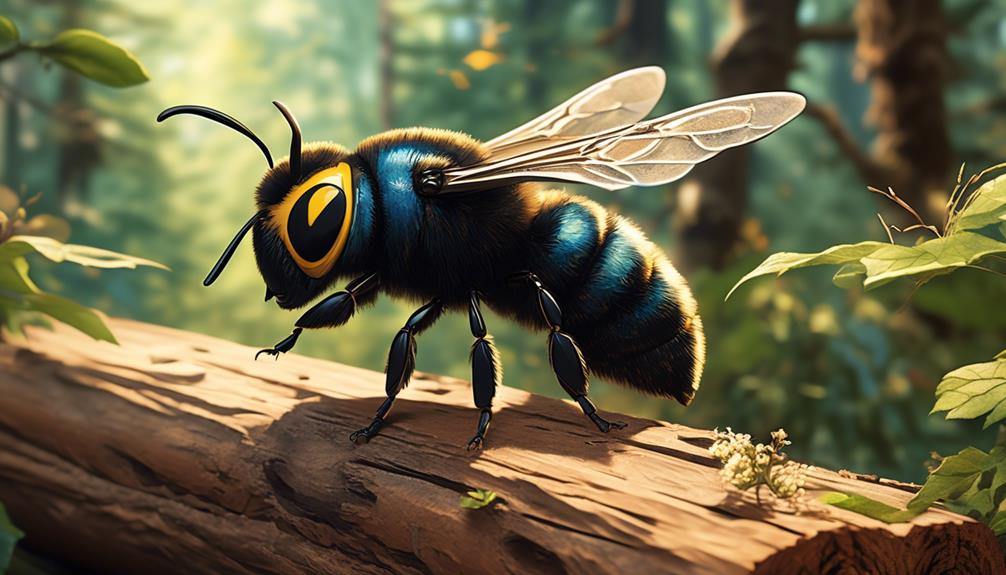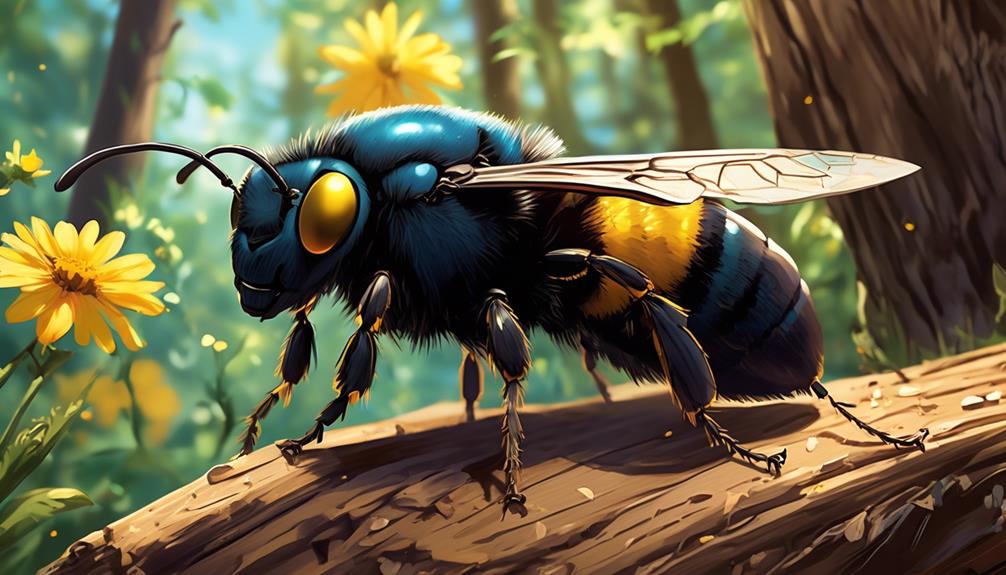Witness the fascinating world of Northern Michigan's Carpenter Bees, whose meticulous craftsmanship is both intriguing and challenging for the local environment.

Carpenter Bee Northern Michigan
Like a skilled craftsman meticulously carving into wood, the Carpenter Bee in Northern Michigan burrows into trees and structures to create its home.
You may notice the round, smooth holes in the wood around your property and wonder about the creature responsible.
These bees, while not native to the region, have adapted to the cold winters and are becoming more prevalent.
They're fascinating creatures with unique behaviors that set them apart from other bees.
However, their presence can be a mixed blessing.
We'll explore why that is as we go on, and you might be surprised at the impact these tiny artisans can have on their environment.
Key Takeaways
- Carpenter bees are solitary creatures that excavate tunnels in wood to lay their eggs.
- They prefer softer, weathered or unpainted wood for nesting.
- Carpenter bees are important pollinators and contribute to plant biodiversity.
- While they can potentially bore into human structures, maintaining natural habitats is crucial to mitigate conflicts and support their survival.
Understanding Carpenter Bees

To fully comprehend the behavior and characteristics of carpenter bees, one must delve into their unique biology and life cycle. As a scholar or enthusiast, you'll find it captivating that these large, robust insects belong to the genus Xylocopa, a name derived from the Greek words for 'wood-cutter'.
Carpenter bees are solitary creatures and unlike honeybees, they aren't social insects. Females excavate tunnels in wood to lay their eggs, hence the name 'carpenter'. They're meticulous in their work, creating chambers for each egg and supplying it with a mixture of pollen and nectar.
Their life cycle is annual, and in Northern Michigan, it begins in spring. The newly emerged adults mate and the females begin their wood-excavating work. They lay their eggs in the summer, which hatch into larvae and feed on the stored food. They pupate and overwinter in their wooden nests, emerging as adults the following spring.
You won't usually find them in well-preserved wood, but rather in weathered, unpainted wood. Understanding these nuances of carpenter bees' biology and life cycle can help you better appreciate their role in our ecosystem.
Habitat Preferences in Northern Michigan

Building on your understanding of their biology and life cycle, let's now examine the specific habitat preferences of carpenter bees in Northern Michigan.
As lovers of wood, carpenter bees aren't picky about the type of wood they inhabit, but they do favor softer woods that are easy to burrow into. They're particularly fond of weathered or unpainted wood, such as the posts and eaves of your barn or shed.
In Northern Michigan, where winters can be harsh and long, carpenter bees seek out habitats that offer protection from the elements. They're typically found in forests, where there's an abundance of both food (flower nectar and pollen) and nesting material (dead wood). However, they can also survive in urban areas, using man-made wooden structures as nesting sites.
Carpenter bees are solitary creatures, which means each female has her own nest. However, they're not territorial, so you may find several nests in close proximity. If you notice perfectly round holes in the wood around your property, that's a good sign you've got carpenter bees. Despite their preference for certain habitats, they're adaptable and can be found wherever there's suitable wood and a food source.
Carpenter Bee Behavior and Lifestyle

Delving into the behavior and lifestyle of carpenter bees, you'll find that these insects lead a fascinatingly solitary existence, punctuated by bouts of intense activity during the warmer months. Unlike social bees, such as honeybees, carpenter bees are solitary creatures, each female digging her own nest in wood where she'll lay her eggs.
During the breeding season, typically between April and June, male carpenter bees become territorial, hovering near nests and chasing away intruders. Despite their aggressive behavior, they're essentially harmless as they lack a stinger. Females possess a stinger but aren't aggressive and only use it when threatened.
Carpenter bees aren't just about buzzing and breeding though. They're vital pollinators, transferring pollen from male to female flower parts as they collect nectar for food. This helps in the fertilization and production of seeds, contributing significantly to plant biodiversity.
In their lifecycle, carpenter bees undergo complete metamorphosis, passing through four stages – egg, larva, pupa, and adult – each with unique behaviors and physiological needs. Despite their solitary nature, these insects play a crucial role in their ecosystems, making them an essential part of the natural landscape in Northern Michigan.
Impact on the Local Ecosystem

In understanding the impact of carpenter bees on the local ecosystem, it's crucial to note their role as potent pollinators and wood recyclers in Northern Michigan. You see, these bees gather nectar and pollen from a variety of flowering plants, inadvertently spreading pollen between flowers as they go. This cross-pollination is integral for plant reproduction, biodiversity, and the health of the local ecosystem.
As wood recyclers, carpenter bees contribute to the breakdown of dead or decaying wood, which nourishes the soil and supports the growth of new plant life. They bore into wood to create nests, but contrary to common misconception, they don't consume the wood. Instead, the wood shavings are discarded, decomposing and returning essential nutrients to the soil.
However, it's also important to acknowledge the potential for damage to human structures. While they prefer decaying wood, carpenter bees may bore into sound wood of buildings if suitable habitats are lacking. This highlights the importance of maintaining natural habitats to mitigate potential human-wildlife conflicts.
Managing Carpenter Bees in Your Home

Despite their ecological benefits, if you find carpenter bees making a home in your wooden structures, it's essential to manage their presence to prevent potential damage. You might notice the telltale signs: perfectly round, half-inch holes in your woodwork, and sawdust beneath. Don't panic, there are steps you can take to control their population.
First, identify the sites of infestation. Carpenter bees prefer untreated, weathered wood. They're attracted to eaves, window sills, decks, and outdoor furniture.
Once you've identified the infested areas, you can apply appropriate insecticides. However, ensure you're doing this safely and responsibly, considering the bees' ecological role.
Consider the following table:
Management Strategy | Emotional Impact |
|---|---|
Identification | Relief |
Use of insecticides | Control |
Regular inspection | Assurance |
Professional help | Peace of mind |
Preservation of habitat | Fulfillment |
Regular inspections of your property, and seeking professional help when needed, will provide peace of mind. And remember, preserving their natural habitats can help keep these bees from nesting in your structures, bringing a sense of fulfillment knowing you're contributing to their survival.
Conclusion
In conclusion, you've learned that carpenter bees are a key part of Northern Michigan's ecosystem. Their behavior, lifestyle, and habitat preferences can impact your home and local environment.
While they're beneficial pollinators, they can cause structural damage to your property. Therefore, managing carpenter bee activity is crucial.
Armed with this knowledge, you're better equipped to coexist with these industrious insects while protecting your home.



